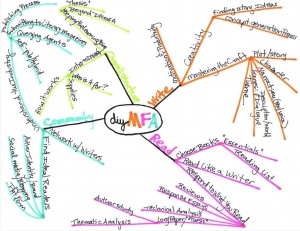Hello and thank you for joining me today!
In this episode–titled Outlining Demystified–we’re going talk about outline techniques particularly geared for writers who hate outlines. When I first started writing, I hated outlines because I thought they were too constricting. Then I discovered these five techniques and a whole new side of writing opened up for me. Now I use outlines for planning my writing projects and for taking inventory after writing a fast first draft.
In this episode, I’ll share with you my five favorite techniques for outlining for any type of genre, so that whatever your project’s needs, there is a tool for the job available. Listen to the episode for a rundown on how each technique works and which types of projects or scenarios work best for each tool. Scroll down to see examples of the different outline methods in action, and also for links to bonus worksheets or other goodies.
5 Techniques for Outlining
1. Mind Mapping
 How: Start with your core idea in the center of the page. Draw branches outward from that main topic to a group of sub-topics. From there, break out branches for your sub-topics into further sub-topics until you have drawn a web across your page.
How: Start with your core idea in the center of the page. Draw branches outward from that main topic to a group of sub-topics. From there, break out branches for your sub-topics into further sub-topics until you have drawn a web across your page.
Why: Mind mapping forces you to look at the same concept from different perspectives.
Best For: Non-fiction or projects that are categorical in nature.
Quick tip: Color code different aspects of your mind map or use highlighter to connect interrelated threads that occur on separate branches.
2. Scene Cards
How: Use one index card for each scene in your story. Include the following four items on each scene card:
- Scene Name: “The scene where…”
- Characters: Who are the major players in this scene?
- Plot Points: What main events happen in this scene?
- Purpose: Why is the scene important? (Hint: If you can’t answer this, then reconsider whether you really need this scene.)
Why: You can see your plot points and scenes all at once and easily rearrange the order until the flow of the plot makes sense to you.
Best For: Fiction or narrative non-fiction, because of its sequential nature.
3. Story Map
H ow: Like a subway map, different plot thread sin your story are represented by different colored lines, with the scenes as the stops along the way. Scenes that serve more than one thread in your story are the express stops, while those that serve only one thread are the local stops.
ow: Like a subway map, different plot thread sin your story are represented by different colored lines, with the scenes as the stops along the way. Scenes that serve more than one thread in your story are the express stops, while those that serve only one thread are the local stops.
Why: This technique allows you to tease apart the various story threads in the novel and see how each thread develops on its own and in relation to the other threads in the story.
Best For: As with scene cards, this technique works best with fiction or narrative non-fiction. Use scene cards to help you build your story map.
4. One-Page Story Sketch
 How: Create a blurb or “flap copy” of your work to summarize it. Do a quick rundown of the main cast, the world, and relevant details of narration. The boil down the message into a fortune cookie type statement that represents the theme of your story (i.e. “There’s no place like home).
How: Create a blurb or “flap copy” of your work to summarize it. Do a quick rundown of the main cast, the world, and relevant details of narration. The boil down the message into a fortune cookie type statement that represents the theme of your story (i.e. “There’s no place like home).
Why: This is a great tool if you need to summarize the important details of your manuscript for a critique group because you can give them context and necessary details quickly.
Best For: Works best with fiction and is especially good for bringing critique partners up to speed on your story.
Download a copy of the Story Sketch worksheet.
5. Mood Board
 How: Collage images that represent the world, the emotion, the characters, and the theme of your project.
How: Collage images that represent the world, the emotion, the characters, and the theme of your project.
Why: Creating and then just looking at your mood board helps you jump into the mind space of the manuscript and get re-centered quickly if you’ve gotten off track. It serves as a good reminder of the intention, the emotion, and the feeling you are going for.
Best For: Fiction or non-fiction, sequential or categorical… basically any project!
Example: The mood board on the left is for a middle grade children’s book about kids who go on road trip adventure.
Resource Recap
There are plenty of additional resources in the DIY MFA archive. To learn more about mind-mapping, scene cards and story-sketches, check out this post with untraditional outline techniques. You can see the step-by-step process for creating The Hunger Games story map in a separate article and the story sketch technique (formerly called a “rough sketch”) has its own detailed article, too. Visit this link to see a mood board in action, and learn how I went from mood board to toy design to story concept.
Link to Episode 21
(Right-click to download.)
If you liked this episode…
Head over to iTunes, leave a review, and subscribe so you’ll be first to know when new episodes are available. Also, if you know anyone who might enjoy this podcast, please share!
Until next week, keep writing and keep being awesome.








